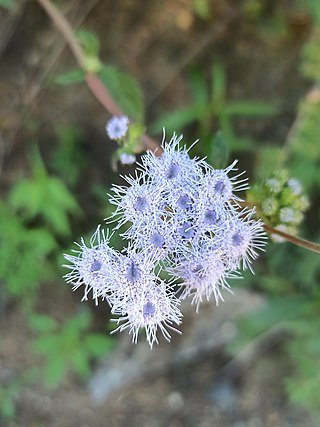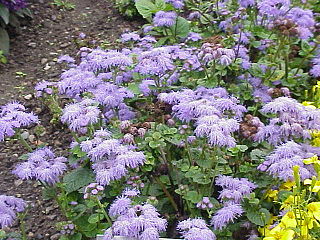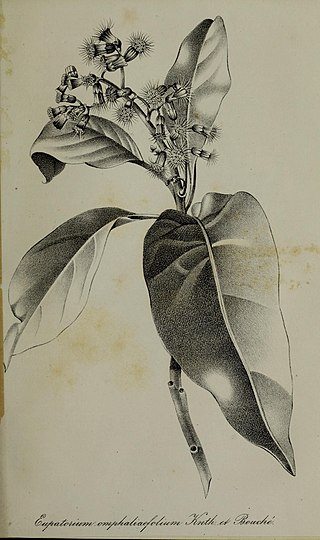
Ageratina, commonly known as snakeroot, is a genus of over 300 species of perennials and rounded shrubs in the family Asteraceae.

Ageratum is a genus of 40 to 60 tropical and warm temperate flowering annuals and perennials from the family Asteraceae, tribe Eupatorieae. Most species are native to Central America and Mexico but four are native to the United States.

Eupatorieae is a tribe of over 2000 species of plants in the family Asteraceae. Most of the species are native to tropical, subtropical, and warm temperate areas of the Americas, but some are found elsewhere. Well-known members are Stevia rebaudiana, a number of medicinal plants (Eupatorium), and a variety of late summer to autumn blooming garden flowers, including Ageratum (flossflower), Conoclinium (mistflower), and Liatris.

Ayapana is a genus of perennial herbs in the family Asteraceae.

Ageratina shastensis is a species of snakeroot which is endemic to Shasta County, California. It is known by the common names Mt. Shasta snakeroot and Shasta eupatorium.
Ageratina cuencana is a species of flowering plant in the family Asteraceae. It is endemic to Ecuador. Its natural habitats are subtropical or tropical moist montane forests and subtropical or tropical high-altitude shrubland. It is threatened by habitat loss.
Ageratina dendroides is a species of flowering plants in the family Asteraceae. It is found only in Ecuador. Its natural habitats are subtropical or tropical moist montane forests and subtropical or tropical high-altitude grassland. It is threatened by habitat loss.
Ageratina macbridei is a species of flowering plant in the family Asteraceae. It is endemic to Peru, where it occurs in several types of habitats, often near rivers.
Ageratina rhypodes is a species of flowering plant in the family Asteraceae. It is found only in Ecuador. Its natural habitats are subtropical or tropical moist montane forests and subtropical or tropical high-altitude grassland. It is threatened by habitat loss.
Ageratina sodiroi is a species of flowering plant in the family Asteraceae. It is endemic to Ecuador, where it is widely distributed in the Andes.

Critonia is a genus of flowering plants in the tribe Eupatorieae of the family Asteraceae.

Fleischmannia is a genus of flowering plant in the family Asteraceae. The name honours Gottfried F. Fleischmann (1777–1850), the teacher of Carl Heinrich Schultz at University of Erlangen–Nuremberg. Members of the genus are native to South, Central, and North America, with some species found as far north as Virginia and Illinois. They are commonly known as thoroughworts.
Hebeclinium is a genus of flowering plants in the family Asteraceae, native to South America and Mesoamerica.

Ageratina riparia, commonly known as mistflower, is a species of flowering plant in the family Asteraceae, native to Mexico. The species is widely adventive and has spread to Cuba, Jamaica, and other parts of the Caribbean. It has also been introduced as an ornamental plant and naturalized in a variety of regions, including parts of Hawaii, South Africa, Southeast Asia, Macaronesia, Oceania, Peru, and the Indian subcontinent. In tropical climates, A. riparia is highly invasive and a variety of control methods have been developed to reduce its spread.

Ageratina adenophora, commonly known as Crofton weed, is a species of flowering plant in the family Asteraceae native to Mexico and Central America. Originally grown as an ornamental plant, it has become invasive into farmland and bushland worldwide. It is toxic to horses, which develop a respiratory disease known as Numinbah horse sickness after eating it.

Ageratina havanensis, the Havana snakeroot or white mistflower, is a species of flowering shrub in the family Asteraceae, native to the south-western United States (Texas), Cuba, and north-eastern and east-central Mexico. Unlike many other species of Ageratina, it is evergreen.
Brickelliastrum is a North American genus of flowering plants in the tribe Eupatorieae within the family Asteraceae. Its species are native to Arizona, New Mexico, and Texas in the United States and to northern Mexico.

Neomirandea is a genus of Central American and South American flowering plants in the boneset tribe within the sunflower family.
Piptothrix is a genus of Mesoamerican plants in the tribe Eupatorieae within the family Asteraceae.
Ageratina lemmonii, called the Lemmon's snakeroot, is a North American species of plants in the family Asteraceae. It is found only in the southwestern United States in the states of Arizona and New Mexico, as well as the states of Sonora, Sinaloa, Chihuahua and Durango in Mexico.










